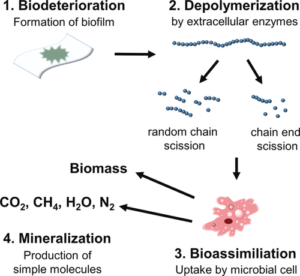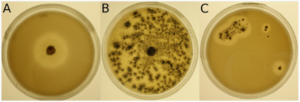The World Environment Day 2023 on 5 June, with this year’s motto “Solutions to Plastic Pollutions,” aims to beat the global plastic pollution that we have created. One approach to dealing with plastic waste involves microbial remediation. An efficient method could focus on microbial strains from the Neodevriesia or the Lachnellula sp. able to degrade plastic at low temperatures. Sarah Wettstadt explains for the #FEMSmicroBlog how cold-adapted microbes might be the key to a healthier environment. #MicrobiologyEvents
Biodegradable plastics against plastic waste
Plastic overproduction and waste mismanagement have led to accumulated plastic litter all over the environment. Its most important feature – high durability – represents its biggest challenge – resistance to biodegradation.
To recycle and break down plastic waste, chemical or mechanical methods require very harsh and toxic chemicals, an immense energy input, or are often too expensive to run.
This is why tiny fragments of durable synthetic polymers, for example, polyethylene, accumulate in the environment, affecting water and soil chemistry. Eventually, non-biodegradable microplastic fragments of less than 5 mm encounter plants, animals and humans, impacting their growth, health and reproduction.
To circumvent the long-term impact on the environment and our health, biodegradable plastics (bioplastics) are a promising alternative. The process is based on microorganisms and their abilities to form biofilms on solid bioplastic fragments, hydrolyse the polymers with extracellular enzymes, and assimilate the smaller molecules. Within the cytosol, microbes then metabolise and degrade the shorter molecules producing biomass and natural products, like carbon dioxide and water. For example, Actinobacteria isolated from compost were shown to degrade the bioplastic polylactic acid at 50 °C – 55 °C.

Bioplastic degradation by cold-adapted microbes
Like other enzymatic reactions, the degradation rate of bioplastics depends on the surrounding of the plastisphere – the enriched microorganisms in a plastic-associated environment. The concentration of enzymes, plastic-degrading microorganisms, as well as temperature, pH, humidity, oxygen concentration, and light, can impact the time needed to completely hydrolyse a bioplastic polymer.
Cold-adapted microorganisms can produce enzymes which are active at temperatures between 0 °C and 30 °C; they often have broad substrate specificity. These features make cold-adapted microorganisms interesting, energy-efficient solutions in industrial processes.
Recently, researchers identified 22 microbial strains identified in the plastisphere of Arctic and alpine soils able to fully degrade bioplastics made of polyester-polyurethane. Of those, strains from Lachnellula sp., Neodevriesia sp. and Amycolatopsis sp. break down bioplastics made of polylactic acid and polybutylene adipate-co-terephthalate. Since these results were achieved after growth at 15 °C for 28 days together with the bioplastic, these cold-adapted microbial strains are energy-efficient alternatives in comparison to other plastic degraders.

This study supported findings from previous works; fungal strains from the Pseudogymnoascus genus are abundant in soils of cold environments and have bioplastic-degrading abilities at low temperatures. Likewise, bacteria from the orders Burkholderiales, Pseudomonadales and Streptomycetales are dominant taxa in the plastisphere.
Optimising bioplastic management
Bioplastics are investigated as sustainable alternatives to non-hydrolysable plastics like polyethylene, but we are still far from optimal plastic waste management. Pathogenic bacteria were shown to grow on plastic and bioplastic fragments in oceans without breaking them down. After consuming the organic matter on the fragments, these bacteria detach and spread into the oceanic environment.
In the soil, the microbial communities in the plant-associated rhizosphere and the plastisphere differ. This change in the rhizosphere microbiome can lead to a decrease in its nutritional status, and to an accumulation of plant pathogens that can use bioplastics as vectors.
Saving our environment and protecting our planet’s health should be in everyone’s mind right now. That’s why this year’s motto “Solutions to Plastic Pollutions” should remind us all to use less plastic to release the burden on the environment. However, to tackle the already present plastic waste, cold-adapted plastic-degrading microbes might be the key. While their metabolic features still need to be better understood and probably even optimised, they could bring us closer to a healthier environment.
- Discover more microbe days on #FEMSmicroBlog: Celebrating microbes every day
- Read also: #FEMSmicroBlog: Microplastics in soil impact microbial communities and plant health
 Dr Sarah Wettstadt is a microbiologist-turned science writer and communicator writing for professional associations and life science organisations. She publishes the blog BacterialWorld to share the beauty of microbes and bacteria, runs the Sunny Scientist to brighten up scientific days and is blog commissioner for the FEMSmicroBlog. Her overall vision is to empower through learning, which is why she founded SciComm Society to coach scientists in science communication. Previous to her science communication career, she did a PhD at Imperial College London, UK, and a postdoc at the CSIC in Granada, Spain. In her non-science time, Sarah enjoys the sunny beaches in Spain playing beach volleyball or travels the world meeting old and new friends.
Dr Sarah Wettstadt is a microbiologist-turned science writer and communicator writing for professional associations and life science organisations. She publishes the blog BacterialWorld to share the beauty of microbes and bacteria, runs the Sunny Scientist to brighten up scientific days and is blog commissioner for the FEMSmicroBlog. Her overall vision is to empower through learning, which is why she founded SciComm Society to coach scientists in science communication. Previous to her science communication career, she did a PhD at Imperial College London, UK, and a postdoc at the CSIC in Granada, Spain. In her non-science time, Sarah enjoys the sunny beaches in Spain playing beach volleyball or travels the world meeting old and new friends.
About this blog section
The section #MicrobiologyEvents for the #FEMSmicroBlog reports about events and meetings relevant to our network. These include world awareness days, FEMS-sponsored meetings or meetings of Member Societies and many more.
| Do you want to be a guest contributor? |
| The #FEMSmicroBlog welcomes external bloggers, writers and SciComm enthusiasts. Get in touch if you want to share your idea for a blog entry with us! |
